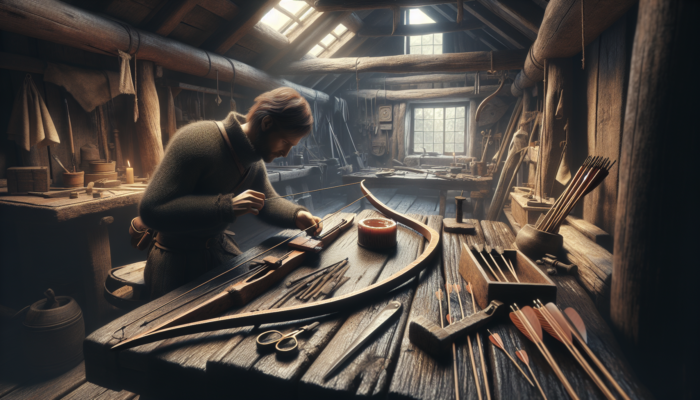Elevate Your Hunting Skills: Effective Strategies for Mastering Primitive Weapon Techniques
Deepen Your Understanding of Primitive Hunting Methods

Engaging in primitive weapon hunting not only hones your hunting abilities but also cultivates a profound relationship with the natural world. This ancient pursuit is founded on methods developed over countless generations, highlighting the necessity of comprehending both the environment and the behavior of the animals you aim to hunt. In contrast to modern hunting, which often depends on sophisticated technology and specialized gear, primitive hunting celebrates innovation, simplicity, and the ability to adapt to varying conditions.
To embark on your primitive hunting adventure successfully, it is vital to acquire a comprehensive knowledge of your environment. Being familiar with local vegetation and wildlife enhances your awareness and aids in predicting animal behavior according to seasonal shifts. For instance, during autumn, deer typically migrate in search of nourishment, while spring prompts increased activity due to mating instincts. Recognizing these behavioral trends not only improves your hunting effectiveness but also nurtures a deep respect for the intricate balance of ecosystems.
Additionally, mastering the tools at your disposal is key to successful hunting. Bows, spears, and traps become extensions of your physical and mental capabilities. The journey of learning how to craft and effectively utilize these tools is an integral aspect of the primitive hunting experience. Although this process demands patience and dedication, the immense satisfaction gained from mastering these skills is unparalleled. Your weapon’s effectiveness directly correlates with your understanding of its mechanics and your proficiency in its application.
Essential Skills for Achieving Success in Primitive Weapon Hunting
To excel in the art of hunting with primitive weapons, it is crucial to develop a broad range of skills that extend beyond mere physical strength. A foundational skill is the ability to create and maintain your hunting tools. Whether it involves shaping a bow from a robust piece of wood or crafting a spear from a sharpened branch, acquiring these competencies not only equips you with essential tools but also instills a deep sense of pride and connection to your hunting experiences.
Another vital skill involves interpreting the signs of nature. This includes tracking animals, understanding their habits, and recognizing indicators of their presence, such as footprints, droppings, or disturbed vegetation. Effectively interpreting these clues can often be the decisive factor between a successful hunt and a missed opportunity.
Adaptability is yet another indispensable attribute for any aspiring primitive hunter. Conditions can change rapidly due to unpredictable weather, shifts in animal behavior, or variations in your physical state. The most accomplished hunters are those who can think on their feet and modify their strategies as circumstances evolve. This flexibility applies not only to the hunt itself but also to the tools and techniques employed.
Fostering Patience and Stealth for Success in Primitive Hunting
In the realm of hunting with primitive weapons, developing patience and stealth is critical. Unlike modern hunting techniques that may prioritize speed and advanced technology, the primitive approach often emphasizes the art of waiting and careful observation. Wildlife possesses keen awareness of its surroundings, making any sudden movements or loud noises likely to alert them to potential threats.
A successful primitive hunter must master the ability to blend into their environment, utilizing natural camouflage and moving quietly through the underbrush. This may involve adopting a low profile, leveraging the terrain, and strategically choosing optimal hunting times. Notably, dawn and dusk are particularly fruitful times for hunting, as many animals display heightened activity during these hours.
Moreover, nurturing a profound sense of patience is essential. The excitement of hunting goes beyond the pursuit; it encompasses the entire experience. The serene moments spent in nature can be as fulfilling as the eventual success of the hunt. Embracing this mindset allows hunters to derive greater satisfaction from their endeavors, building a strong connection with the land and its inhabitants.
Choosing the Right Gear for Effective Primitive Weapon Hunting

Explore Different Types of Primitive Weapons: Bows, Spears, and Atlatls
Selecting the right weapon is crucial in hunting with primitive weapons, as each type offers distinct advantages and challenges. Bows, often hailed as the quintessential primitive weapon, are celebrated for their accuracy and range. Crafting a bow requires knowledge of materials and expertise in the tension and flexibility necessary for optimal performance. Traditional bows can be fashioned from woods like yew or ash, and mastering the art of stringing and shooting them is immensely rewarding.
Spears represent another fundamental tool in primitive hunting. Depending on the hunter’s preferences and skill level, they can be utilized for both thrusting and throwing. Crafting a spear involves selecting an appropriate shaft and creating a sharp point, often through the process of flint knapping. The versatility of spears makes them applicable for various hunting scenarios, whether targeting larger game or smaller animals.
Atlatls, or spear-throwers, introduce an exciting dimension to primitive hunting. These tools enhance both the power and distance with which thrown spears can travel, allowing hunters to engage prey from a safer distance. Mastering the use of an atlatl necessitates practice and precision, making it a captivating aspect of primitive weaponry.
Engaging in the Crafting Process of Your Primitive Hunting Equipment
Creating your primitive hunting gear is an essential aspect of the experience, significantly enriching your connection to the tools you employ. The crafting process not only imparts valuable skills but also fosters a deep respect for the natural materials you source. When embarking on this creative journey, it is crucial to consider the properties of different materials. For example, selecting the right wood for a bow requires understanding its grain and flexibility, while crafting arrows necessitates knowledge of feather types and fletching techniques.
The crafting process can also serve as a meditative experience, encouraging introspection and a deeper appreciation for the hunt. Each step, from material selection to the final touches, transforms into a valuable learning opportunity. Moreover, incorporating traditional techniques passed down through generations can enrich your understanding of this timeless craft.
Furthermore, crafting your gear instills a sense of pride and accomplishment. When you venture into the field with equipment you have personally fashioned, each shot and encounter gains added significance, reinforcing the bond between hunter and nature.
Ensuring the Maintenance and Care of Your Primitive Weapons

Proper maintenance and care are essential for the performance and longevity of primitive weapons. Unlike modern firearms or equipment, which may require minimal upkeep, primitive tools demand a proactive approach. Regular inspection and maintenance are vital to ensure your weapons remain in peak condition.
For bows, this involves checking for any signs of wear, such as fraying strings or cracks in the wood. Periodically applying wax to the string can enhance its durability, while storing the bow in a dry location helps prevent warping. Likewise, arrows should be routinely examined for damaged fletching or broken shafts to ensure they are flight-ready.
Spears and atlatls also require attention. Regularly sharpening the points and inspecting the shafts for splinters or cracks is crucial. Natural oils can help protect wooden tools from environmental elements, significantly extending their lifespan.
By establishing a diligent maintenance routine, hunters can ensure that their primitive weapons remain dependable partners in their hunting journeys, deepening their trust in the tools that connect them to the age-old art of hunting.
Mastering Tracking Techniques for Successful Primitive Weapon Hunting
Develop Your Skills in Identifying Animal Tracks and Signs
The ability to identify animal tracks and signs is one of the most crucial skills in a primitive hunter’s toolkit. Each footprint narrates a story, providing insights into the animal’s size, behavior, and health status. While this skill may appear daunting to novices, it becomes an intuitive part of the hunting experience with consistent practice.
Understanding the fundamentals of animal tracks involves recognizing specific patterns. For instance, deer tracks are generally heart-shaped, while wild boar tracks are more rounded. The spacing between tracks can also reveal the animal’s speed and direction. This knowledge empowers hunters to focus their efforts more strategically, thereby increasing their chances of a fruitful hunt.
In addition to tracks, other indicators such as droppings, scrapes, and rubs offer valuable information. For example, fresh droppings indicate recent activity in the area, while scrapes on trees may suggest that a deer is marking its territory. Learning to decipher these signs not only enhances your hunting success but also cultivates a deeper appreciation for the intricacies of wildlife.
Techniques for Tracking and Analyzing Animal Trails
Once you have mastered the ability to identify animal tracks, the next step is to refine your techniques for following and analyzing trails. This skill requires keen observation and a patient approach. When tracking, it is imperative to move slowly and quietly, allowing for a deeper connection with your surroundings.
Pay close attention to the terrain and consider how it may influence animal movement. Animals typically choose paths of least resistance, favoring areas with ample cover or water sources. Observing these patterns can help you anticipate where to find them.
Additionally, recognizing subtle signs left behind can elevate your tracking capabilities. This includes noting broken twigs, crushed grass, or disturbed leaves, all of which may indicate an animal’s recent passage. As you follow a trail, remain aware of your surroundings, as animals may sometimes return to their tracks, leading you closer to them.
Utilizing Natural Elements to Improve Your Tracking Skills
The natural environment offers abundant resources that can significantly enhance your tracking skills. The landscape acts as a guide, with various elements providing clues to animal behavior. For instance, being conscious of wind direction is crucial, as animals often rely on scent for navigation. Understanding how the wind carries odors can greatly aid in positioning yourself for a successful hunt.
Natural features such as water sources, hills, and dense vegetation are vital for tracking. Animals depend on these features for shelter and movement, making them hotspots for potential encounters. Recognizing these patterns can lead to successful hunts.
Furthermore, integrating knowledge of local flora can also be advantageous. Certain plants may attract specific animals, indicating areas where your hunting efforts could yield better results. By embracing the natural world as your ally, you can develop a holistic approach to tracking, ultimately enhancing your success in primitive hunting.
Upholding Ethical Practices and Conservation in Primitive Hunting
The Importance of Primitive Hunting in Wildlife Management
The practice of hunting with primitive weapons goes beyond personal enjoyment; it plays a vital role in wildlife management. Engaging in primitive hunting can help maintain ecological balance by assisting in the management of healthy populations of various species.
By participating in regulated hunts, primitive hunters help control overpopulated species, prevent habitat degradation, and ensure that ecosystems remain vibrant and diverse. When conducted ethically, this form of hunting can support wildlife populations and promote biodiversity.
Moreover, primitive hunting fosters a deeper understanding of the relationship between humans and the natural world. It encourages hunters to become stewards of the land, advocating for conservation efforts and highlighting the importance of preserving natural habitats. By engaging in wildlife management practices, hunters can champion sustainable practices that benefit the environment and future generations.
Balancing Hunting with Conservation Efforts
The delicate balance between hunting and conservation is essential in primitive weapon hunting. Ethical hunters recognize the significant environmental impact of their actions and strive to minimize their footprint. This includes adhering to regulations, avoiding overhunting, and respecting breeding seasons.
Beyond personal responsibility, hunters can actively participate in conservation initiatives. This may involve joining local wildlife organizations or supporting efforts aimed at habitat preservation. By doing so, hunters contribute to the long-term health of the ecosystems they rely upon.
Furthermore, educating others about the importance of sustainable hunting practices is crucial. By sharing knowledge and experiences, primitive hunters can advocate for responsible behaviors that respect wildlife and their habitats, fostering a culture of conservation within the hunting community.
Embracing Ethical Hunting Practices with Primitive Weapons
<pAnyone hunting with primitive weapons must adopt ethical hunting practices. This commitment includes adhering to fair chase principles and maintaining respect for the animal and the hunting experience. Ethical hunters ensure their methods are humane and take only what they need.
Understanding the importance of making accurate shots is also crucial. This means being proficient with your weapon and recognizing when conditions are unsuitable for a clean kill. Striving for precision reflects respect for the animal and minimizes suffering.
Additionally, ethical hunters should be aware of the broader implications of their actions. Engaging with local communities, understanding cultural sensitivities, and respecting indigenous practices can enrich the hunting experience while promoting unity among those passionate about the natural world. Ultimately, ethical hunting fosters a deeper connection to the land and its inhabitants.
Safety Considerations and Legal Aspects of Primitive Weapon Hunting
Familiarizing Yourself with Local Hunting Regulations and Required Permits
Hunting with primitive weapons requires a comprehensive understanding of local hunting regulations and necessary permits. Each region has its own set of rules designed to promote safety and conservation, placing the responsibility on the hunter to familiarize themselves with these laws.
Permits may be essential for specific types of hunting or within designated areas. These regulations help manage wildlife populations and protect habitats, ensuring the sustainability of hunting practices. Before setting out on a hunt, consult local wildlife agencies to obtain the necessary documentation and stay informed about any regulatory updates.
Moreover, understanding seasonal restrictions and bag limits is vital. Many regions designate specific hunting seasons to protect breeding populations and facilitate sustainable hunting practices. Adhering to these laws demonstrates a commitment to responsible hunting and helps maintain the integrity of the sport.
Implementing Safety Measures When Utilizing Primitive Weapons
Safety must always take precedence when hunting with primitive weapons. While these tools may not pose the same risks as modern firearms, they can still cause serious injury if not handled properly. When crafting or utilizing bows, spears, or atlatls, you must remain vigilant of your surroundings and potential hazards.
Wearing appropriate safety gear, such as gloves and sturdy footwear, can help protect against injuries. Keeping a reliable first aid kit on hand is essential, enabling you to address minor injuries during your hunting activities.
Moreover, practicing safe hunting involves being mindful of fellow hunters and ensuring effective communication. Establishing clear boundaries and utilizing signals can help prevent accidents, fostering a safer hunting environment for everyone involved.
Preparing for Emergencies and First Aid in the Wilderness
Accidents can occur outdoors, making first aid and emergency preparedness essential for a successful hunting expedition. When hunting with primitive weapons, it is crucial to be equipped to handle potential injuries or emergencies that may arise.
A well-stocked first aid kit should include fundamental supplies such as bandages, antiseptics, and pain relief medications. Additionally, knowledge of essential first aid techniques can prove invaluable in addressing injuries promptly and effectively. Understanding how to treat common outdoor injuries, such as cuts, scrapes, or insect bites, can significantly enhance safety during your hunt.
Furthermore, preparing for emergencies extends beyond first aid. Familiarizing yourself with the area you plan to hunt is vital, including understanding the terrain, potential hazards, and the location of nearby assistance if needed. Always inform someone of your hunting plans and estimated return time to ensure that help can be sought promptly.
Learning from Indigenous Cultures in Primitive Weapon Hunting
Exploring Traditional Hunting Methods of Indigenous Peoples
The wisdom of indigenous cultures provides invaluable insights into hunting with primitive weapons. These communities have refined their skills and techniques over centuries, developing methods that are deeply intertwined with their cultural identities. Traditional hunting practices often encompass a holistic understanding of the land, wildlife, and seasonal cycles.
Indigenous hunters utilize a variety of tools and techniques, often shaped by their unique environments. For example, some cultures may rely heavily on traps and snares, while others emphasize the use of bows and arrows. This diversity in methodologies reflects the adaptability and creativity of indigenous peoples in response to their surroundings.
Moreover, the spiritual connection to the land is fundamental to indigenous hunting practices. Many cultures regard hunting as sacred, emphasizing respect for animals and the environment. This reverence nurtures a deep sense of responsibility towards conservation and sustainability, principles that modern hunters can learn from and integrate into their practices.
Honoring and Upholding Indigenous Hunting Traditions
Anyone hunting with primitive weapons must respect and preserve indigenous hunting traditions. Acknowledging the historical and cultural significance of these practices fosters mutual respect between hunters and indigenous communities.
Engaging with indigenous cultures can provide invaluable context for contemporary hunters. This may involve attending workshops, participating in cultural exchange programs, or simply listening to the stories and teachings of indigenous elders. By learning from these experiences, hunters can enhance their understanding of the land while nurturing a sense of unity and respect.
Furthermore, supporting indigenous rights and advocating for the preservation of traditional lands is essential. This can involve participating in conservation initiatives or backing policies that protect indigenous communities and their cultural practices. By standing in solidarity, hunters can contribute to the ongoing survival of these rich traditions.
Integrating Indigenous Knowledge into Modern Primitive Hunting Practices
Incorporating indigenous knowledge into contemporary hunting practices with primitive weapons can significantly enrich the hunting experience. This approach acknowledges the depth of understanding indigenous peoples possess regarding the natural world and their sustainable methods of interaction with it.
For instance, many indigenous cultures have developed specific tracking and hunting techniques finely tuned to their local ecosystems. Learning these methods can provide modern hunters with innovative strategies and insights that may not be readily available in contemporary literature.
Additionally, embracing indigenous perspectives on wildlife management fosters a more ethical and sustainable approach to hunting. This includes recognizing the interconnectedness of species and the importance of maintaining balance within ecosystems. By adopting these teachings, hunters can cultivate a deeper respect for nature and their role within it.
Contemporary Applications and Competitions in Primitive Weapon Hunting
Applying Primitive Hunting Skills in Survival and Bushcraft Scenarios
The skills associated with hunting with primitive weapons are invaluable in survival and bushcraft situations. In contexts where modern conveniences may be absent, the ability to hunt and gather food using traditional methods becomes a critical skill set.
Primitive hunting techniques facilitate a deep connection with the environment, fostering self-reliance and resourcefulness. Complementing bushcraft skills such as foraging for edible plants and constructing shelters creates a comprehensive survival strategy.
Moreover, honing these skills enhances your confidence in outdoor settings. The knowledge you gain in providing for yourself through primitive methods empowers you and reinforces the significance of self-sufficiency in the wilderness.
Participating in Primitive Hunting Competitions and Events
Engaging in primitive hunting competitions and events offers a unique opportunity to showcase your skills and share experiences with like-minded individuals. These gatherings frequently celebrate traditional techniques, cultivating a sense of community and camaraderie among participants.
Competitions may encompass various elements of primitive hunting, such as archery, spear-throwing, and tracking challenges. Such events enable hunters to test their abilities while providing a platform for learning and exchanging knowledge with others who share a passion for the craft.
Participation in these events can also elevate awareness regarding the significance of preserving traditional hunting practices and promoting ethical hunting behaviors. By demonstrating the skills involved in primitive hunting, participants can inspire others to connect with nature and appreciate the cultural importance of their pursuits.
Integrating Primitive Hunting into Outdoor Education Programs
Incorporating hunting with primitive weapons into outdoor education programs can provide invaluable learning experiences for individuals of all ages. These programs teach essential skills such as tracking, weapon crafting, and understanding ecosystems, fostering a deeper appreciation for the natural world.
Outdoor education initiatives centered on primitive hunting can encourage teamwork, problem-solving, and resilience. Participants learn to collaborate, share knowledge, and develop a sense of responsibility towards their environment.
Furthermore, these programs can promote conservation awareness, instilling values of sustainability and ethical hunting practices. By engaging with the principles of primitive hunting, participants can cultivate a lifelong respect for nature and their role within it.
Sharing Personal Stories and Experiences in Primitive Weapon Hunting
Reflecting on Memorable Encounters and Lessons Learned from Primitive Hunting
Personal narratives and experiences in the realm of hunting with primitive weapons often underscore the profound connections formed between hunters and nature. Each encounter in the wild imparts unique lessons, whether it involves understanding animal behaviors or developing skills in the field.
For many, the first successful hunt becomes a treasured memory, symbolizing the culmination of efforts and the journey of learning and growth. The exhilaration of the chase, the tranquil moments of stillness, and the eventual connection with wildlife can impart valuable insights into oneself and the natural world.
Moreover, sharing these stories cultivates community and connection among fellow hunters. Each narrative serves as a testament to the learning journey and the joys of immersing oneself in nature, inspiring others to embark on their own adventures.
Overcoming Challenges and Celebrating Achievements with Primitive Weapons
Hunting with primitive weapons often presents challenges, yet overcoming these obstacles contributes to the rewarding nature of the experience. From mastering the intricacies of weapon crafting to developing the patience required for tracking, each hurdle becomes an opportunity for personal growth.
Many hunters recount frustrations experienced during failed hunts or adverse conditions. However, these experiences frequently yield invaluable lessons about resilience, adaptability, and the significance of perseverance. Each challenge in the field teaches hunters to refine their techniques, develop new strategies, and approach the hunt with a refreshed perspective.
Ultimately, the successes achieved through primitive hunting come with a profound sense of fulfillment that transcends the act itself. The journey of honing skills, connecting with nature, and learning from both triumphs and setbacks fosters a deeper appreciation for the art of hunting.
Finding Joy and Fulfillment Through a Deep Connection with Nature in Hunting
At its essence, hunting with primitive weapons offers a profound sense of joy and fulfillment that extends beyond the act of hunting itself. Engaging intimately with nature fosters a deep connection to the environment, providing a sense of belonging and purpose.
The serene moments spent in the wilderness, whether waiting for an animal to approach or absorbing the beauty of the surroundings, can be immensely rewarding. These experiences promote mindfulness and reflection, allowing hunters to appreciate the subtleties of the world around them.
Moreover, the sense of achievement derived from refining one’s skills and connecting with nature creates lasting memories and a deep-rooted respect for wildlife and ecosystems. Through this pursuit, hunters often find themselves not only as participants in the hunt but also as custodians of the land, advocating for its preservation and sustainability for future generations.
Resources and Learning Opportunities in Primitive Weapon Hunting
Exploring Books, Websites, and Communities for Primitive Hunting Enthusiasts
A plethora of resources is available for those interested in exploring the art of hunting with primitive weapons. Numerous books delve into various facets of primitive hunting, offering insights into traditional techniques, crafting skills, and ecological awareness. Titles authored by respected figures in the field provide both foundational knowledge and advanced strategies for aspiring hunters.
Additionally, various websites and online communities cater to primitive hunting enthusiasts. These platforms serve as valuable hubs for sharing knowledge, experiences, and tips among like-minded individuals. Participating in discussions and forums can enhance your understanding of the craft and connect you with fellow hunters, fostering a sense of community.
Moreover, many local organizations focus on primitive skills and hunting. Joining these groups can provide access to workshops, events, and networking opportunities, enabling you to learn from experienced hunters and expand your skill set.
Participating in Workshops and Courses on Primitive Hunting Techniques
Engaging in workshops and courses dedicated to hunting with primitive weapons can significantly enhance your skills and knowledge. These programs often provide hands-on experiences, allowing participants to learn essential techniques in a supportive environment.
Workshops may cover various topics, including weapon crafting, tracking, and ethical hunting practices. Alongside practical skills, these courses often integrate discussions on conservation and the cultural significance of primitive hunting, offering a comprehensive understanding of the craft.
Moreover, learning from experienced instructors can provide invaluable insights and tips that may not be readily available in books or online resources. The opportunity to ask questions and receive immediate feedback can accelerate your learning process, making these workshops a worthwhile investment in your hunting journey.
Connecting with Mentors and Experienced Primitive Hunters
Finding a mentor or connecting with experienced primitive hunters can greatly enrich your journey in hunting with primitive weapons. Mentorship provides the opportunity to learn directly from those who have refined their skills over many years, offering guidance and support as you navigate your path.
Many seasoned hunters are eager to share their knowledge and experiences, often enjoying the opportunity to pass on traditional techniques and insights. Building relationships within the hunting community can lead to valuable mentorship, collaboration, and shared learning opportunities.
Additionally, seeking out local hunting clubs or groups can facilitate connections with experienced hunters. Engaging with these communities enriches your understanding of primitive hunting and helps you develop the skills necessary for success. Ultimately, these connections foster camaraderie and support, enhancing the overall experience of hunting with primitive weapons.
Frequently Asked Questions About Primitive Hunting
What types of primitive weapons are commonly used for hunting?
Primitive weapons, including bows, spears, and atlatls, are utilized for hunting through traditional techniques developed over centuries. These methods offer a more intimate and challenging way to engage with wildlife.
How do I start my journey in hunting using primitive weapons?
To begin hunting with primitive weapons, it’s essential to learn about the tools, develop necessary skills such as tracking and crafting, and familiarize yourself with local regulations. Engaging with experienced hunters or enrolling in workshops can provide invaluable insights.
Are there specific animals that are best suited for hunting with primitive weapons?
Many hunters find that small to medium-sized game, such as deer, rabbits, and birds, are best suited for hunting with primitive weapons. The choice typically depends on the hunter’s skill level and the local ecosystem.
What skills are essential for successful primitive hunting?
Key skills for successful primitive hunting include weapon crafting, tracking, stealth, patience, and a solid understanding of animal behavior and natural surroundings.
How can I learn about indigenous hunting practices?
To learn about indigenous hunting practices, consider attending workshops, engaging with local indigenous communities, or reading literature on traditional techniques and their cultural significance.
What safety precautions should I take while hunting with primitive weapons?
Safety precautions include wearing suitable gear, being aware of your surroundings, maintaining your weapon, and carrying a first aid kit. Understanding hunting regulations is also critical.
How does primitive hunting contribute to conservation efforts?
Primitive hunting can contribute to conservation by helping manage wildlife populations responsibly, promoting habitat preservation, and fostering a sense of stewardship among hunters.
Can I craft my primitive hunting gear?
Crafting your primitive hunting gear is a rewarding aspect of the experience. It allows you to connect with your tools and learn essential skills like woodworking and flint knapping.
What types of competitions exist for primitive hunting?
Primitive hunting competitions often include events focused on archery, spear-throwing, and tracking challenges, providing a platform for participants to showcase their skills and learn from others.
Where can I find resources for further learning about primitive hunting?
Books, online communities, workshops, and local hunting organizations offer resources for further learning. Engaging with experienced hunters can also provide valuable insights and guidance.
Join Us on Facebook for More Insights
The post Hunting with Primitive Weapons: An Essential Guide appeared first on Survival Bite.
The Article Primitive Weapons for Hunting: Your Essential Guide Was Found On https://limitsofstrategy.com



